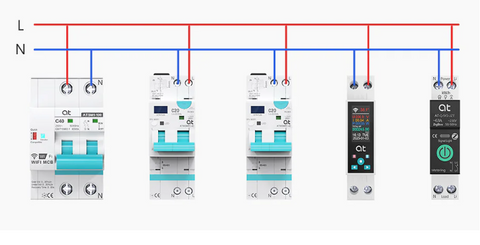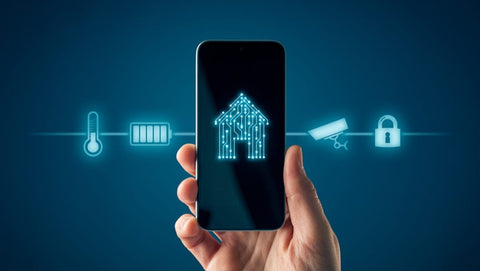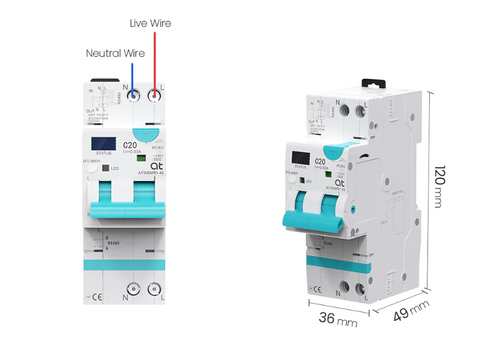Smart Breakers 101: A Guide to Understanding and Installing
Inside this Article:
- I. Understanding Smart Breakers
- II. Advantages of Smart Breakers
- A. Improved Energy Efficiency
- B. Enhanced Safety Features
- C. Integration with Smart Home Ecosystems
- D. Potential Cost Savings Over Time
- III. Considerations Before Installation
- A. Compatibility with Existing Electrical Systems
- B. Smart Home Ecosystem Integration
- C. Budget Considerations
- D. DIY vs. Professional Installation
- IV. Step-by-Step Installation Guide
- V. Case Studies
- VI. Conclusion
As technology continues to advance, so does the need for a more sophisticated and responsive electrical infrastructure. Smart breakers play a pivotal role in meeting this demand, offering homeowners the ability to remotely monitor and manage their electrical systems. This comprehensive guide aims to demystify smart breakers, emphasizing their significance in promoting both convenience and safety in the modern home.

I. Understanding Smart Breakers
A. Definition and Purpose of Smart Breakers
Smart circuit breakers are advanced electrical components that go beyond the conventional role of protecting circuits from overloads and short circuits. These intelligent devices incorporate technology to enable features such as remote monitoring, energy management, and enhanced safety protocols.B. Key Features and Benefits
1. Remote Monitoring and Control
One of the standout features of smart breakers is the ability to remotely monitor and control electrical systems. Homeowners can access real-time data on energy usage, receive alerts for potential issues, and even remotely manage the power supply to specific circuits.2. Energy Management Capabilities
Smart breakers empower users to optimize energy consumption by providing insights into usage patterns. With this information, homeowners can make informed decisions to reduce energy waste, ultimately contributing to lower utility bills and a more sustainable living environment.3. Safety Enhancements
Beyond the fundamental role of circuit protection, smart breakers incorporate advanced safety features. These may include the ability to detect abnormalities in the electrical system, shut down power remotely in emergency situations, and provide detailed diagnostics to facilitate quick issue resolution.C. Types of Smart Breakers

1. WiFi-Enabled Smart Breakers
Utilizing standard WiFi connectivity, these smart breakers enable seamless integration with home networks. This allows users to control and monitor their electrical systems remotely through dedicated applications.2. Bluetooth-Enabled Smart Breakers
Bluetooth-enabled smart breakers offer a more localized connection but still provide the convenience of wireless control. Ideal for smaller spaces or applications where WiFi connectivity may be limited.3. Zigbee and Z-Wave Smart Breakers
Smart breakers compatible with Zigbee or Z-Wave protocols offer the advantage of mesh networking, allowing for enhanced reliability and coverage in larger homes or complex electrical systems.Understanding the distinctions among these types of smart breakers is crucial when considering integration into your home.
II. Advantages of Smart Breakers
A. Improved Energy Efficiency
Smart breakers contribute significantly to improved energy efficiency within homes. By providing real-time insights into energy consumption patterns, users can identify areas of inefficiency and implement changes to reduce overall energy waste. The ability to remotely monitor and control specific circuits allows for on-the-fly adjustments, optimizing energy usage and ultimately leading to lower utility bills.B. Enhanced Safety Features
Safety is paramount when it comes to electrical systems, and smart breakers take it to the next level. These intelligent devices can detect anomalies in the electrical grid, such as irregular currents or potential hazards, and respond by shutting down power to prevent accidents. Advanced safety protocols and remote monitoring capabilities provide homeowners with peace of mind, knowing that their electrical system is equipped to handle unforeseen circumstances.C. Integration with Smart Home Ecosystems
One of the key advantages of smart breakers is their seamless integration with broader smart home ecosystems. They can communicate with other smart devices, such as thermostats, lighting systems, and security systems. This interconnectedness allows for a holistic approach to home automation, enabling users to create custom scenarios and automate responses based on specific conditions or events.D. Potential Cost Savings Over Time
While the initial investment in smart circuit breakers may seem significant, the potential for cost savings over time is a compelling factor. The combination of improved energy efficiency and the ability to prevent electrical issues before they escalate can lead to reduced maintenance costs and lower energy bills. Additionally, the enhanced lifespan of smart breakers compared to traditional counterparts contributes to long-term savings.III. Considerations Before Installation

A. Compatibility with Existing Electrical Systems
Before diving into the world of smart breakers, it's crucial to assess the compatibility with your existing electrical infrastructure. Ensure that your electrical panel supports the installation of smart breakers and that the chosen devices align with the specifications of your system.B. Smart Home Ecosystem Integration
For a truly smart home experience, consider how well the smart breakers integrate with your existing or planned smart home ecosystem. Compatibility with popular platforms and protocols ensures a smooth and cohesive automation experience.C. Budget Considerations
While the long-term benefits are substantial, it's essential to establish a realistic budget for the initial investment. Compare the features offered by different smart breakers within your budget range to find the best balance between cost and functionality.D. DIY vs. Professional Installation
The decision between a do-it-yourself (DIY) installation and seeking professional help depends on your comfort level with electrical work and the complexity of the installation process. While some may find the installation straightforward, others might prefer the expertise of a professional to ensure a safe and reliable setup.IV. Step-by-Step Installation Guide
Embarking on the installation of smart breakers is an exciting endeavor that can elevate your home's electrical system. This step-by-step guide is designed to walk you through the process, ensuring a smooth integration of intelligent technology into your existing setup.A. Pre-installation Preparations
1. Turning Off the Power
Safety is paramount when working with electrical systems. Begin by turning off the power to the electrical panel that you'll be working on. Identify the correct circuit breaker and switch it off to ensure a safe environment for installation.2. Gathering Necessary Tools
Before starting the installation, gather the essential tools you'll need for the job. This may include a screwdriver, wire stripper, voltage tester, and any specific tools recommended by the smart breaker manufacturer. Having everything on hand will streamline the process and prevent unnecessary interruptions.B. Installing Smart Breakers

1. Wiring and Connection Process
Carefully follow the manufacturer's instructions for wiring the smart breakers. This typically involves removing the existing breaker, connecting the smart breaker to the electrical panel, and securing it in place. Pay close attention to the labeling on the smart breaker to ensure correct installation.2. Connecting to the Smart Home Network
Once the physical installation is complete, it's time to connect the smart breaker to your home network. This step may involve using a mobile app or a dedicated hub provided by the manufacturer. Follow the setup instructions to establish a secure connection, enabling remote monitoring and control features.C. Testing and Troubleshooting
1. Ensuring Proper Functionality
After installation and network connection, test the smart breaker to ensure proper functionality. Verify that you can control it remotely, monitor energy usage, and receive alerts if applicable. Check that the breaker responds appropriately to commands and that all connected devices function as expected.2. Troubleshooting Common Issues
In the event of any issues, refer to the troubleshooting section of the manufacturer's instructions. Common issues may include connectivity issues, device malfunctions, or errors in the setup process. Utilize any provided diagnostic tools and, if needed, contact customer support for guidance.
Remember, if you encounter challenges during the installation or if you are uncomfortable with any aspect of the process, seeking the assistance of a professional electrician is a wise decision. Safety and accuracy are paramount in ensuring the successful integration of smart breakers into your home.
V. Case Studies
A. Real-World Examples of Smart Breaker Installations
1. Smart Breakers Enhance Home Automation
In this case study, a homeowner integrated smart breakers into their existing smart home ecosystem. By connecting the smart breakers to other devices such as thermostats, lights, and security systems, the homeowner created automated scenarios for energy savings and enhanced security. The result was a seamlessly interconnected home with improved efficiency and convenience.2. Emergency Shutdown Prevents Potential Hazard
In another instance, a smart breaker detected irregularities in the electrical system indicative of a potential hazard. The breaker initiated an emergency shutdown, preventing a more severe issue. The homeowner received an immediate alert and was able to address the problem promptly, showcasing the enhanced safety features of smart breakers in action.B. Success Stories and Lessons Learned
1. Cost Savings Over Time
Several users reported noticeable reductions in their energy bills after installing smart breakers. By actively monitoring and optimizing energy usage, these homeowners achieved long-term cost savings that outweighed the initial investment in the technology.2. Lessons in Compatibility
A homeowner shared their experience of initially overlooking the importance of compatibility with their existing electrical system. After encountering issues during installation, they sought professional advice to ensure seamless integration. The lesson learned was the significance of assessing compatibility beforehand, avoiding potential complications.VI. Conclusion
As technology evolves, embracing smart breaker technology opens doors to a more connected, efficient, and secure home. The ability to monitor and control your electrical system remotely, optimize energy usage, and enhance safety is a testament to the potential benefits of this intelligent technology.
In the ever-changing landscape of smart home technology, staying informed and open to adopting new advancements ensures that you are at the forefront of creating a home that is not only intelligent but also efficient and secure. Smart breakers are just one piece of the puzzle in the evolving narrative of modern living, and their potential impact on the future of electrical systems is truly electrifying.
Contact:
sale@at-ele.com



